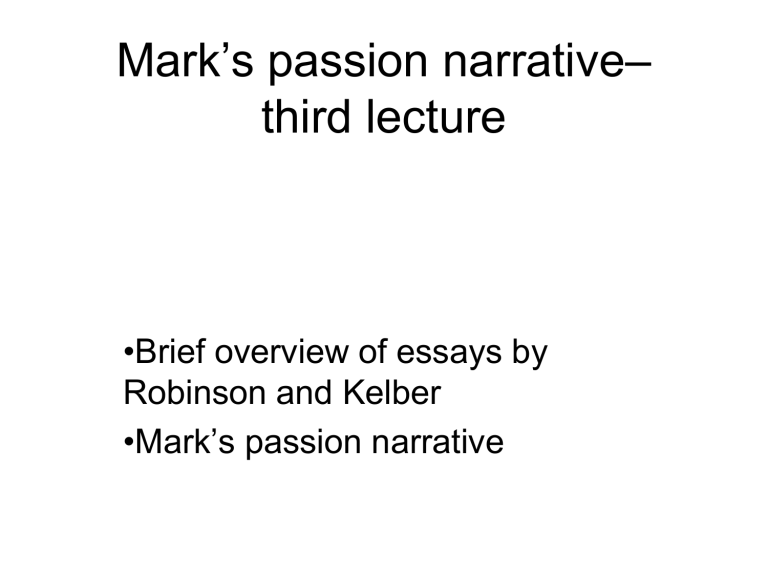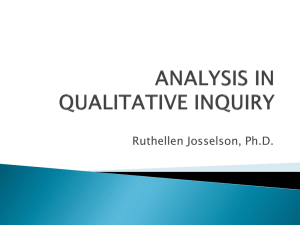Mark`s passion narrative– third lecture

Mark’s passion narrative– third lecture
•Brief overview of essays by
Robinson and Kelber
•Mark’s passion narrative
Robinson, “Gospels as narratives”
• Much of essay is speculative, but interestingly so.
• Tends to see a negative element in the scripting of the gospel.
• The heart of the matter is his contrast of Mark with an itinerant, radical sort of movement, centered on sayings
– and possibly open to appearances of the resurrected
Jesus.
• Such appearances would leave a corresponding openness to new sayings (i.e., resurrected Jesus would continue teaching).
• Sees Mark as reticent about sayings, resurrection appearances.
• Mark’s scripted character aim to close the tradition of a
“living Jesus” who continues to appear, teach.
• Sees this textual limiting as continuing in Matthew and
Luke, who correspondingly “tame” Q by swallowing it up.
Kelber, “Narrative and Disclosure
• Sees Mark as writing a “disorienting-reorienting narrative which forestalls closure.”
• Emphasizes the insider/outsider dichotomy seen in the parable of sower (“hina” in Gk. = “so that”).
• Esoteric secrecy inheres in sayings gospels.
• Parables, on other hand, foster an open-endedness toward signification, interpretation.
• Wisdom entrusted to insiders anticipates its eventual openness.
• The secrecy about his identity that Jesus enjoins in fact exerts pressure toward proclamation.
• “Nothing hidden, except to be revealed ; nothing secret, but that it come to light ” (4:22).
• But “the more the narrative struggles to overcome secrecy and to make disclosure, the more it reveils itself in parabolic mystery.”
• Readers are challenged to become “new insiders.”
• How are readers to understand the mysteries of Jesus’ sonship to
God in view of his confession of being forsaken by God?
• The caution of his last paragraph!
Kelber, “Narrative as interpretation and interpretation of narrative”
• Narrative is such a universal part of our experience that we tend to take it for granted, including gospel narrative.
• Sees the parable as the oral genre going back to Jesus that gives rise to narrative: “parable joins proclamation.”
• Follows Robinson in seeing distinction between the portrayal of risen Christ, speaking openly, and the earthly Jesus, speaking in parables.
• Mark, ironically, “redescribed” the element of parable in his technique of “parabolic reversal” to subvert conventional expectations of transmission of narrative to place burden on hearers/readers.
• Mark’s narrative partakes of “parable understanding” – need for interpretation, understanding.
• Manuscript culture doesn’t see texts as fully complete, closed.
• Scribal hermeneutics was based in the involvement of the reader, on
“reader response.”
• “Narrative as interpretation”: if narrative was born in act of interpreting, then readers must be continuing in the same activity.
Teaching in Jerusalem
• Interestingly, it’s Jesus’ cleverness that emerges here.
• He parries the question about his authority by his question about John’s authority: 11: 27ff.
• The parable of the vineyard: 12:1-12.
• The response to the question about taxes to
Caesar.
• Response to the Saducees over resurrection of dead.
• Response to question of the “greatest commandment.”
• The issue of Davidic messiahship. This is important to Matthew and Luke. But Mark has
Jesus rejecting the necessity: 12: 35-37.
• (In Mark Jesus is emphatically a Galilean – no connection with Judea, Bethlehem, Jerusalem.)
Mark’s passion narrative
• Mark’s final three chapters may be the single most influential narrative in our tradition, and perhaps the most powerful.
• Mark’s is the original and source for others – he writes the story first.
• And this connected narrative is the end point toward which all of the gospel has been driving – a culmination of the paradoxical messiahship
Jesus has described.
• Note that the gospel properly ends at 16:8 – with the empty tomb.
• Look at the textual note on p. 58.
• Verses 9-20 appear to have been added in response to Matthew, Luke, and John.
“In remembrance of her . . .” but --
• Passion narrative begins at ch. 14.
• A woman anoints Jesus with 300 denarii worth of ointment (that’s 300 days salary for a laborer!).
• Jesus’ interpretation of the act: “she has anointed my body beforehand for burial.”
• But it’s also a messianic anointing, like Samuel’s secret anointing of Saul (1 Sam. 9-10).
• Here messiahship is again linked to death; the one will mean the other.
• Jesus promises remembrance of the woman.
• But what has happened?
The passover meal – “last supper”
• Mysteriousness of discovery of the messianic donkey repeated in discovery of the upstairs room.
• Celebration linked with betrayal: 14: 17-21.
• Bread of passover and final cup of wine linked with his death – and remembrance.
• Prophecy from Zechariah points to desertion, denial.
• Peter’s vow at v. 31.
• The inability of the inner circle of disciples to stay awake. See J’s admonition at 13: 35-37.
• “All of them deserted him and fled.” v. 50
Peter, messiahship, denial
• Peter follows at a distance.
• High priest puts the question about messiahship.
And only this does Jesus answer.
• Messiahship is judged worthy of humiliation, death.
• And the gentile question, Pilate’s, is actually a statement. And Jesus responds affirmatively.
• And sandwiched between these is Peter’s threefold denial.
• The central insider makes himself an outsider at the most significant moment when J’s identity is proclaimed.
• Romans mock kingship, chief priests messiahship.
Abandonment, death
• Darkness of eclipse.
• Jesus’ final words, given in Aramaic and Greek.
Despair? Shock?
• (Luke will take these words away – simply too shocking. Only Mark – and Matthew following him – will allow these words.)
• How to understand these them?
• The “sour wine” may echo psalm 69:21.
• And paradoxically, the gentile centurion, a complete outsider, speaks the words before spoken by God. Third time spoken in Mark’s gospel (except by those possessed by demons
).
The tomb and the ending of the narrative
• Same three women who witnessed death come to the tomb.
• And hear the message of the mysterious young man.
• And are told to tell Peter and disciples about “going ahead” to Galilee.
• But they say nothing to anyone.
• The end!
• The last word, “gar” (“for”), “postpositive conjunction,” suggests incompletion.
• The message does not get through.
• Was it wrong to remain in Jerusalem?
• Where does leave the reader?
• And what does it mean in terms of the larger story?
The ending, or is it a non-ending?
• Narrative ends, or doesn’t end, mysteriously.
• No sense of narrative resolution.
• Narrative instead handed over to the reader .
• Who must now understand what the women and the disciples did not.
• Is the reader, in a sense, caught inside a parable?
• The whole gospel a kind of parable, in the
Markan sense, that must be opened?
• A question mark -- ? Mark









